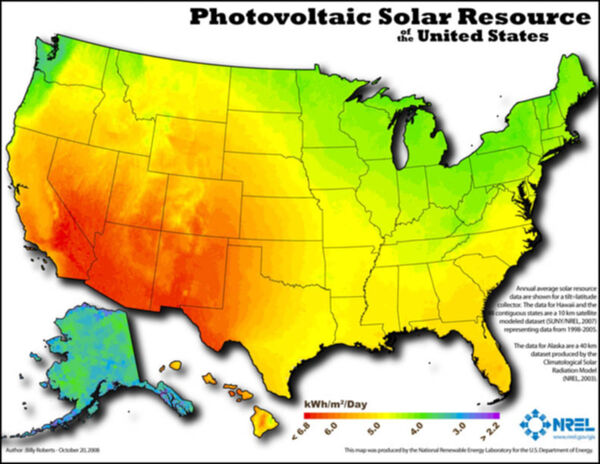While I generally recommend people put together their own solar system from part,s sometimes you just want to get started fast, without the hassle of shopping around. Finally, I’ve found a system that I’m happy to recommend as a basic starter system for yurts, tiny homes, and RVs.
Why I Recommend the Renogy 400W Solar Kit. This kit hits a nice medium in terms of size and price. For under $1,000 this little kit will produce enough to charge cell phones, run LED lights at night, and power small DC appliances like fridges, laptops, TVs, and electronics.
View Renogy 400 Watt 12 Volt Monocrystalline Solar Starter Kit
Renogy is a respected solar company producing high quality components. Most kits from other manufactures skimp on the quality of charge controller, potentially leaving you without power and wasting the power that you do produce. Good quality MPPT change controllers are a must for any system that I use and recommend to other people, and this kit has one.
Additionally, this kit comes with 4 100W monocrystalline solar panels. While I generally recommend polycrystalline solar panels, which produce the same at less cost, I haven’t found a kit of this quality that comes with them. However, for tiny homes, RVs, and the like with limited space, mono panels may warrant the extra price since they are a bit more compact.
This charge controller can go up to 800W, which means you have the option of doubling your power output later by buying for more panels and increasing your system voltage to 24V volts, which is supported by many 12V appliances.
View Renogy 400 Watt 12 Volt Monocrystalline Solar Starter Kit
How Much Power Will the Renolgy 400W Solar Kit Produce?
In average solar conditions, this kit will produce about 2kWh power per day. This all depends on how much sun you get in your area. You can determine the average amount power this system will produce by finding your color on the map, and multiplying the number that color corresponds with by 400.

Be aware that this number is only an average, and varies throughout the year. To determine exactly how much you power you will get and how much power you need throughout the seasons, click through to my complete guide below —
What You Can Run on the Renology System
As a rule of thumb, here are some common usages power requirements by appliance, as well has how long you could run them per day under ideal conditions assuming an average solar irradiance of 5 on the map above.
| Appliance | ~Usage (W) | ~Hours of Use / Day |
|---|---|---|
| Clothes Dryer | 3000 | 0.66 |
| Electric Oven | 2400 | 0.8 |
| Dishwasher | 1800 | 1.11 |
| Electric Stove Top (per burner) | 1500 | 1.33 |
| Toaster Oven, Microwave | 1200 | 1.66 |
| Window AC, Space Heater | 1000 | 2 |
| Coffee Maker | 800 | 2.5 |
| Clothes Washer | 500 | 4 |
| Refrigerator | 250 | 8 |
| Computer | 200 | 10 |
| TV, Monitors | 100 | 20 |
| Laptop | 60 | 33 |
| Lights, Florescent (per bulb) | 15 | 133 |
| Lights, LED (per bulb) | 10 | 200 |
| Wifi Router | 6 | 333 |
| USB charged devices | 5 | 400 |
View Renogy 400 Watt 12 Volt Monocrystalline Solar Starter Kit
What Else You Need
The Renology system comes with a charge controller, 4 solar panels, and solar wire. While you can run a solar system off this alone, there are several additional parts you might consider buying —
Batteries
Without batteries this system will not produce power at night, or on some cloudy days. In order to keep things running, you will need some batteries.
The proper battery for this system is a deep cycle battery suitable for high depth of discharge. Hooking up car starter batteries to this system will ruin the batteries very quickly.
While you may be able to find cheaper batteries locally, crappy batteries really make the off grid experience much more difficult than it needs to be. And, because they tend to not last as long, you end up paying more in the long run.
To match the Renology 12V Solar Kit,I recommend two to four of these Renology deep cycle batteries. These hybrid gel batteries are maintenance free, and work with the Renology charger right out of the box. Just plug everything in an go.
Renogy Deep Cycle Hybrid Gel 12 Volt 100Ah Battery
Two of these batteries will store 1.2kWh, about half of typical daily production. If find that is a good starting point, as just one battery discharges too quickly the way the most people use them.
If live in area with many cloudy days, like I do, you will probably want a larger power reserve. Four batteries is about the perfect size for that since it can almost charge in one full day of bright sun.
Inverter
The system as is will only run DC appliances. Most commonly, people will run car accessories, DC appliances for RVs, or USB powered devices directly on these smaller systems. Running appliances directly from DC is more power efficient, requiring fewer conversion, and DC appliances tend to be designed with energy efficiency in mind.
However, if you intend to plug something in to a wall power socket or extension cord, you will need an AC inverter. This converter turn DC battery power in to wall AC that you would typically get from grid power. Allowing any appliance to be used off grid, so long as it doesn’t use too much power.
This 300W inverter is pretty well matched to a system this size. However, if you intend to up your panels to 800W in the future, you might consider going for a 750W 12V/24V inverter now.
See 300W AC Inverter on Amazon
Safety & Connectors
While this charge controller has built in short circuit protection, it’s 40A rated current is plenty to drain the batteries quickly in case of partial short.
It is good practice to wire a DC system with a fuse box, much like the breaker box in your home, with the 40A spread across smaller circuits sized for that particular need. For more help on this, see my visual guide to wiring off grid solar systems —
Here is a good quality fuse box to get you started
Most DC appliances can be wired directly to the terminals in their circuit block. However some automotive DC appliances will need a cigarette lighter socket to plug in to. For instance, the inverter above requires a cigarette lighter socket to connect to the system. You can get those here —




